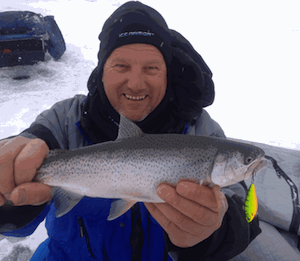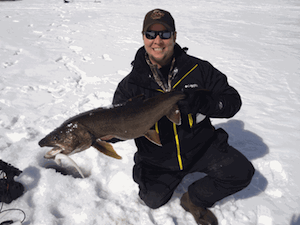Fast-Forward Ice Fishing
Category: npaa
Dec 23rd, 2013 by OutdoorsFIRST
Modified Dec 23rd, 2013 at 12:00 AM
Ice fishing success hinges on a number of factors, not the least of which are finding the fish, then dialing in the right presentation to trip their triggers. Sadly, too many winter warriors venture out without a solid plan of attack, and this season in particular, such oversights could cost countless catches.
Trouble is, winter blew into town early across much of the Ice Belt. And in many areas, its arrival was coupled with heavy snows that closed the shades on light penetration. As a result, the underwater world went dark sooner than normal, which means seasonal transitions that typically occur in February may be coming down the pike well ahead of schedule.
 |
|
|
|
Fortunately, anglers with a plan can still enjoy banner catches, and few know the drill better than veteran guide Bernie Keefe. Hailing from the high-altitude paradise of Granby, Colorado, he religiously tracks location and presentational trends to keep clients’ strings stretching. While his main focus is the salmonid smorgasbord found in his local mountain lakes, which includes beefy lakers, ‘bows, browns and kokanees, his predictions for premature patterns hold water for species and situations sprinkled across the North.
“We have to shift gears early this season,” he warns. “What should happen in February will happen in January.” To prepare, Keefe studies journal jottings from past winters, noting where, when and how trout were taken in midwinter under normal conditions, so he can apply those tactics early in 2014. “Such research puts me ahead of the game, so I can prepare for the coming changes and opportunities,” he adds.
One of the February patterns he expects to emerge early is a suspended lake trout bite. “Lakers weighing 10 to 15 pounds and up cruise anywhere from one to 15 feet beneath the ice, over deeper water, hunting small rainbows and other baitfish,” he says. “When they’re in this mode, they smash lures with a vengeance, especially right beneath the ice, so it pays to be ready.”
To tap the bite, he rigs a supersize softbait such as a 7-inch Berkley Gulp! Jerk Shad on a 4/0 to 5/0 Lazer TroKar #810 jig hook, or a 10-inch Hogy Original on a 1- to 1½-ounce jighead. “There’s no finesse about it,” he grins. “Yo-yo aggressively with exaggerated, three- to four-foot rod lifts, and hold on tight or you’ll get the rod ripped out of your hands.”
To be sure, not all lake trout cruise the ceiling at once. Many stalk the abyss, where various bottom-oriented approaches bear consideration. But having a rod ready for high flyers can mean an extra two to three trophy trout per trip. Keefe says a sure tipoff that a hungry laker is lurking inches beneath his boots is when a fish bumps a client’s sonar transducer. “When someone says their Vexilar is moving, I tell them to reel up and throw down the big baits, fast,” he says.
 |
|
|
|
Another February pattern Keefe expects to make an untimely debut occurs in rather shallow, pothole-type lakes with ample weedgrowth. “Due to the early, heavy snow, the weeds are dying off sooner,” he begins, explaining that the resulting oxygen shortage around the stricken salad will force trout to suspend over the deepest water available. “Rainbows suspend six feet down over 20 feet of water,” he says. “They have no choice. Oxygen goes out from the bottom up, so they’re pushed up and away from the weeds.”
By anticipating patterns ahead of time, Keefe keeps clients busy battling broad-shouldered lake trout.
Here, Keefe’s go-to tactic is attracting trout with a bright, flashy Clam Speed Spoon. “This calls them in,” he says. “I seal the deal with a small panfish jig.” Top picks include Clam’s Drop and Duckbill Drop tungsten jigs, tipped with waxworms, a Maki plastic, or piece of Gulp! softbait. The jig should hang perfectly still, in deadstick mode. “A spring bobber helps detect bites, which can be phenomenally light,” he says, noting that Clam’s Nitinol spring bobbers are his weapons of choice.
Also working in his favor is the fact that most anglers remain faithful to shallower weeds that yielded fish early. When the action stalls, they pack it in for the season. “Fishing pressure drops, and continuous waves of trout roll into my fishing area,” he says. “This pattern gets better as winter progresses, and lasts until oxygenated meltwater flows in just before ice-out.”
When fishing both the sky-high laker and oxygen depletion patterns, Keefe keeps an eye on the water below. “It’s a great way to spot fish, and see how they react to your jigstrokes,” he says, adding, “You can lie on the ice and watch, but I prefer sitting in a comfortable portable like my Clam Legend.” Just another trick for tackling midwinter trout come early.
For more information or to book a trip with Keefe, visit: fishingwithbernie.com or call (970) 531-2318.